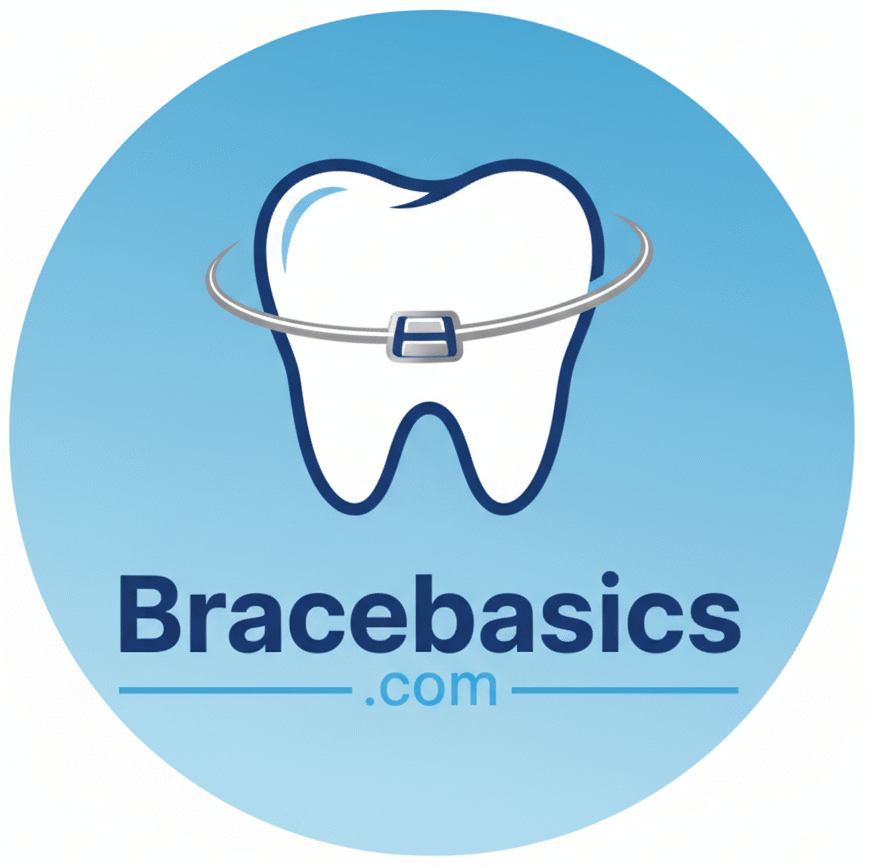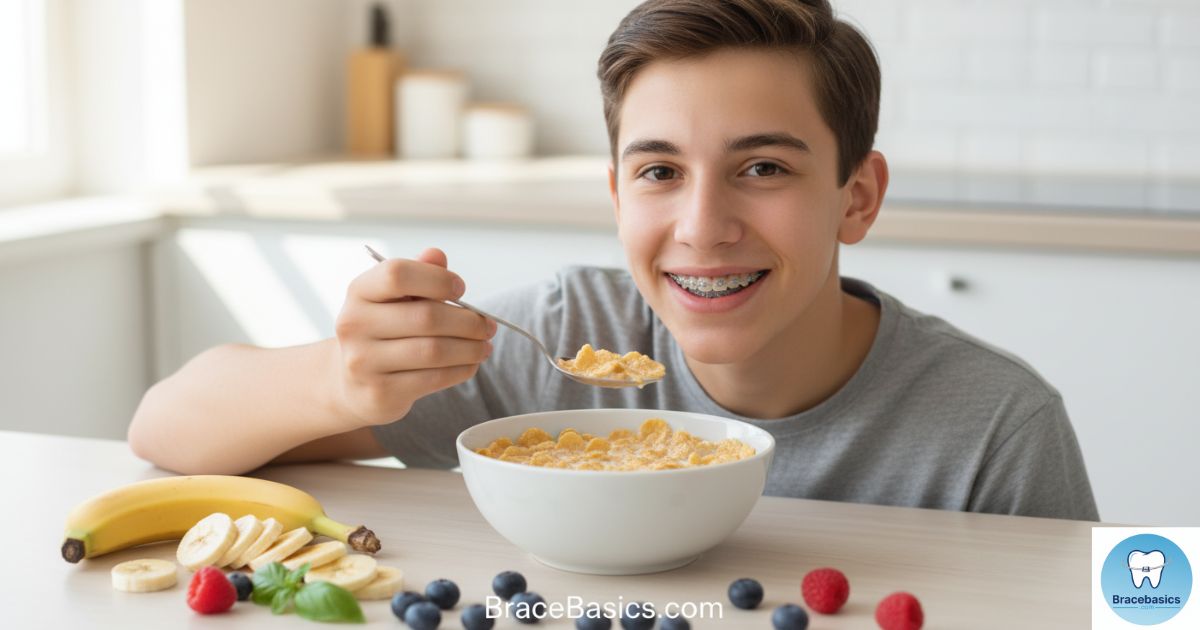Mornings often start with a craving for cereal. But when you have braces, that crunchy bowl of flakes might feel risky. The good news: yes — you can eat cereal with braces, but you’ll need to choose wisely and act carefully. You care about avoiding damage to brackets, bending wires, and keeping your teeth clean. In this article you will learn what cereals are safe, which to avoid, and how to eat cereal with braces without harming your orthodontic treatment.
Can You Eat Cereal With Braces?
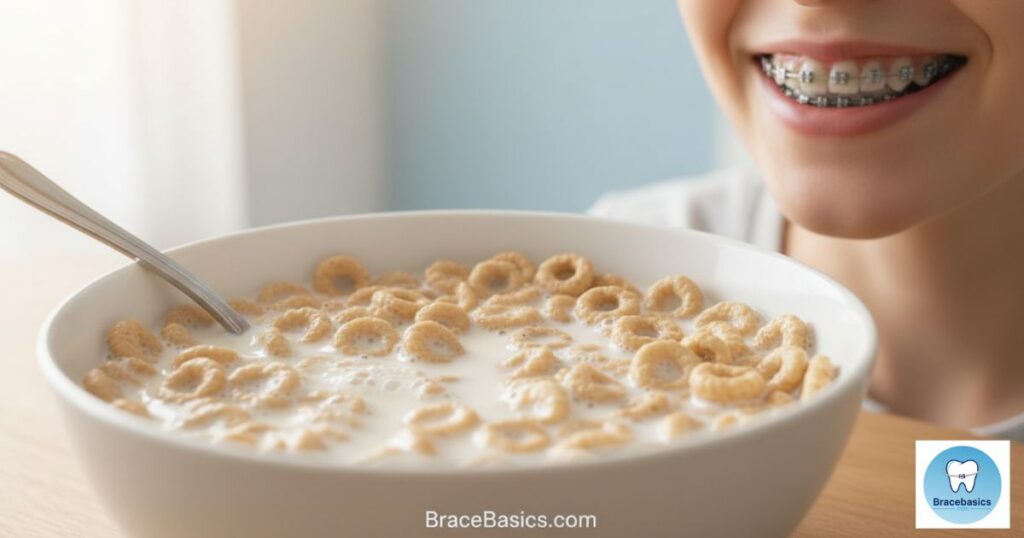
Yes, you can eat cereal with braces, but it depends on texture, preparation, and how you clean afterward. If you pick a cereal that’s soft or that dissolves easily, you reduce the risk of damaging orthodontic treatment, dental braces care, or your hardware. The key lies in choosing braces-friendly foods, soaking, chewing gently, and maintaining oral hygiene with braces. In this post you’ll discover safe cereals, risky cereals, tips for eating cereal with braces, and what orthodontist advice suggests.
What You Need to Know About Eating Cereal With Braces
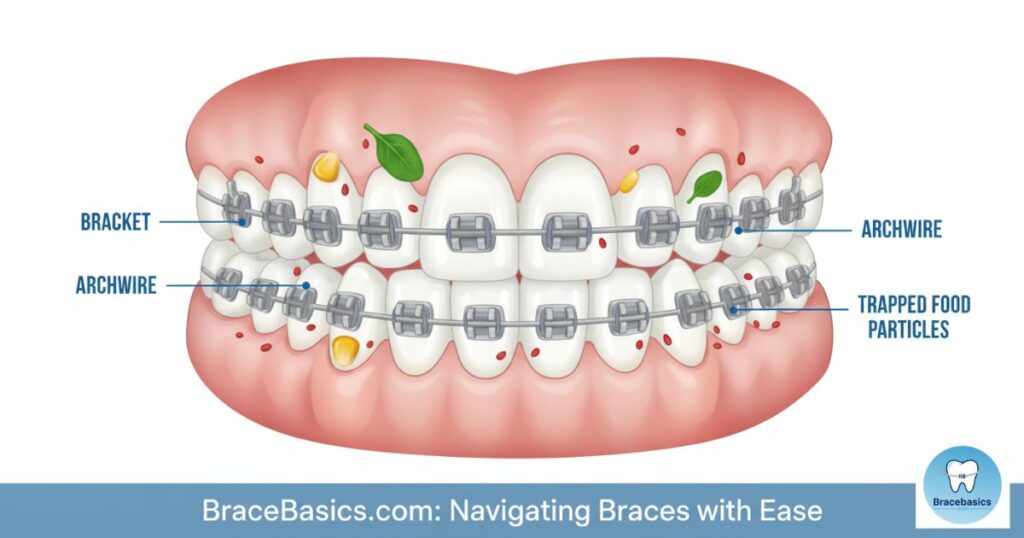
Braces consist of brackets, wires, and sometimes elastics that attach to your teeth. These components create many nooks and edges where food can get trapped. When you bite down on something hard or crunchy, the force and sudden stop can bend wires, loosen brackets, or even break parts. Also, sticky or sugary cereal particles cling around the hardware and can lead to plaque buildup around braces, which raises the chance of tooth decay. During the first days after your braces are placed or after an adjustment, your teeth often feel more sensitive, so eating anything firm or coarse increases discomfort.
As you chew, food can wedge itself under wires or behind brackets. Over time, that trapped debris helps bacterial growth and decay. That is why you must favor cereals and foods that do not resist breakdown and are easier to dislodge. Also, be gentle in chewing and avoid biting with the front teeth when possible, shifting work to back molars.
What Cereals Can You Eat With Braces?
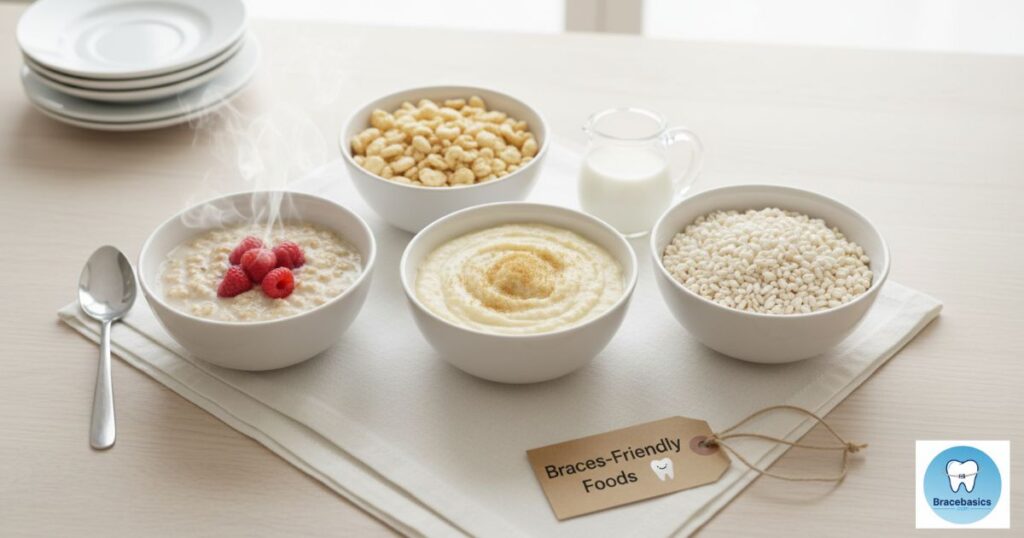
Soft or Soggy Cereals
When cereal is softened or already gentle, your braces have much less stress. Oatmeal, rolled oats soaked into a porridge, or cooked cereals like cream of wheat or cream of rice slide smoothly past brackets. Even regular flakes, if soaked long enough, become soft enough to chew safely. Soaking dissolves much of the structure, reducing risk.
Puffed Cereals
Puffed rice or puffed wheat tend to be light, airy, and brittle. Because they crumble easily, they exert much less stress on your wires or brackets. Even if small bits remain, they’re less likely to cause damage.
Instant Breakfast Cereals
Instant oatmeal packs or quick-cook flakes are designed to dissolve rapidly with liquid. They turn soft quickly and are gentler on braces. Be cautious of high sugar content, which can increase decay risk if debris sticks around.
Smooth Cereals
Ultra-fine options such as rice cereal (think “baby-style” or very fine grits) or other fine grain cereals can slide off your braces with minimal resistance. These serve as a gentle alternative when your mouth is sore or if you worry about damage.
Cereals to Avoid
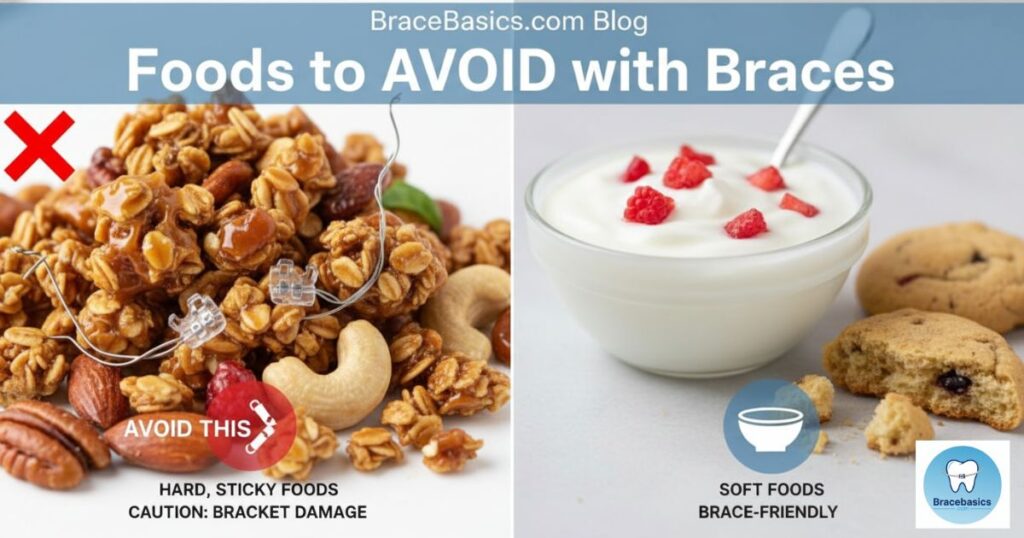
You should steer clear of crunchy, hard cereals such as granola, clusters, cereals with large nut pieces, or thick toasted flakes. Clusters and “crunch bits” often contain mix-ins like nuts, dried fruit, or coatings that can stick or dig into wires. Very sugary cereals are also problematic — sugar plus brackets is a prime environment for decay. These risky cereals can damage brackets, bend wires, or become lodged where you can’t easily remove them, disrupting the progress of your orthodontic treatment.
7 Smart Ways to Enjoy Cereal With Braces Safely
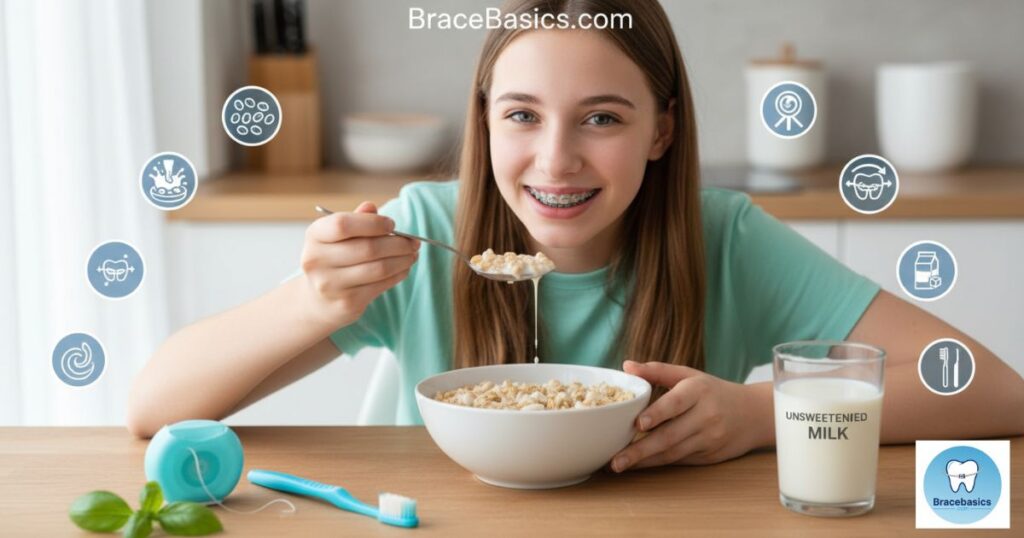
Eating cereal with braces doesn’t have to be stressful. By following these seven smart and dentist-approved habits, you can protect your brackets, avoid discomfort, and still enjoy your favorite breakfast. Each method focuses on soft texture, good hygiene, and mindful eating.
- Soften your cereal before eating. Add milk or warm water and wait one to two minutes until the flakes lose their crunch.
- Pick light, airy options. Choose puffed rice cereal or soft grains that crumble easily instead of hard granola.
- Avoid sticky or sugary coatings. Steer clear of sticky cereal problems like caramel or dried fruit that cling to braces.
- Chew slowly and use back teeth. Gentle chewing prevents damaged brackets and wires.
- Rinse and brush right after breakfast. Remove leftover bits quickly to stop plaque buildup around braces.
- Use low-sugar milk alternatives. Sweetened milks can add to sugar and tooth decay, so go for unsweetened almond or oat milk.
- Keep cleaning tools close. Carry a water flosser, floss threader, or interdental brush to clean between meals.
These smart methods make breakfast both safe and satisfying. When you eat mindfully and maintain oral hygiene with braces, even cereal becomes a braces-friendly treat.
Choose Carefully When You Eat Cereal With Braces
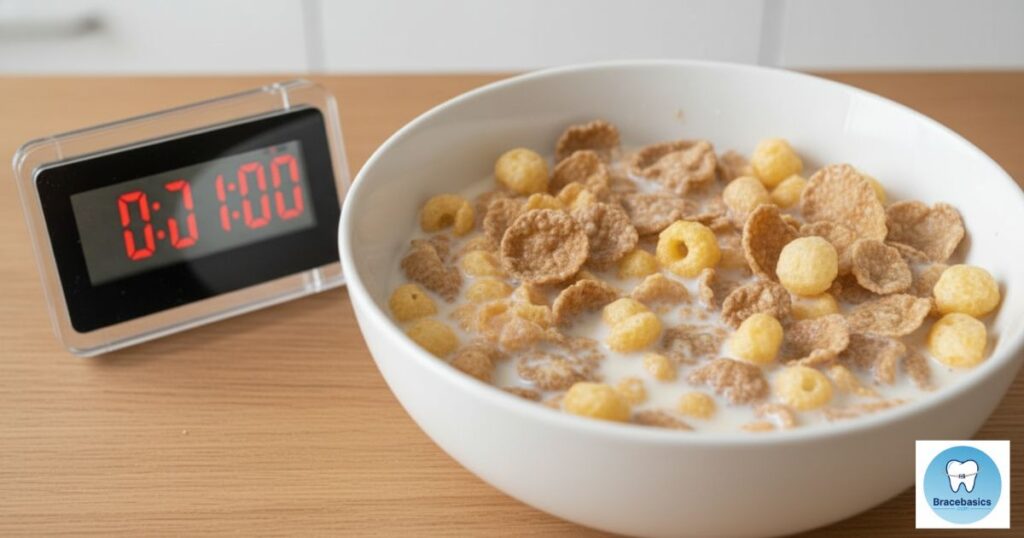
Always pour milk or liquid as soon as you add the cereal so the texture softens. Let the cereal soak a minute or two so the pieces soften before any chewing. If you have large chunks, break them into smaller bits to reduce stress on your braces. Use your back teeth for chewing and avoid biting directly with your front teeth. Eat slowly and mindfully so you catch problems early. After finishing, rinse your mouth well and brush/clean braces soon after to remove residual particles before they cause harm.
Tips for Eating Cereal With Braces
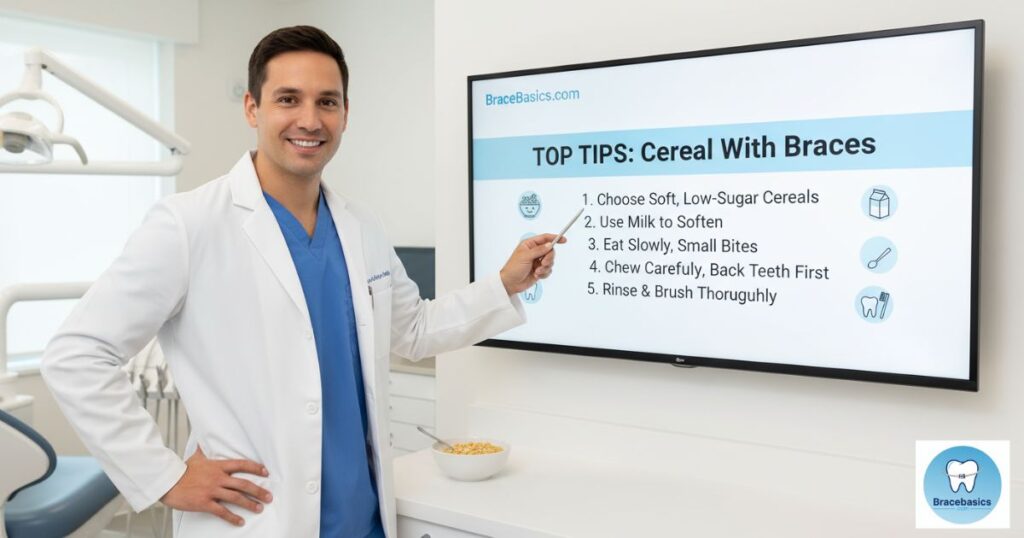
Soften cereals with milk (dairy or non-dairy) and allow a little wait for better texture. Choose milks that are low in added sugar to avoid extra decay risk. Crush or cut large bits before putting them in your mouth rather than biting directly. Brush gently but thoroughly after breakfast, paying attention to wires, brackets, and the gum line. Avoid sticky toppings such as caramel or honey clusters that cling to hardware. Use a straw when drinking leftover milk to reduce contact with your brackets. Keep floss, interdental brushes, or a water flosser handy to clear trapped cereal particles immediately.
Special Considerations
In the first few days after braces placement, teeth often are tender. Stick to very soft cereals like rice cereal or thoroughly soaked oats until discomfort fades. After adjustments, your teeth may be tender again — revert temporarily to gentler cereal types. For children or teens who love crunchy cereal, a good compromise is pre-soaking or crushing before offering. If a bracket loosens or a wire bends while eating, stop, rinse gently, and call the orthodontist for repair rather than forcing continued eating.
Expert Insights & What Orthodontists Say

Orthodontists stress that texture safety, soaking, and cleaning are the pillars of enjoying cereal with braces. Clinics like Wilkinson Orthodontics suggest that soft, low-sugar cereals pose minimal risk when chosen carefully. wilkinsonorthodontics.com.au Other practices warn that crunchy cereals elevate bracket breakage or wire bending. Peterson Family Orthodontics+1 The balance lies in allowing some dietary flexibility while protecting your treatment. Experts repeatedly advise braces diet guide strategies and caution that even “safe” cereals become harmful if you skip cleaning.
Real-Life Case / Anecdotes (Optional)
A teenage patient once bit a large granola cluster and popped a bracket off the front tooth. She switched to soaked oatmeal and puffed rice for two weeks and avoided any crunchy bits. Afterward, she resumed a modified cereal routine without further damage. Her orthodontist later remarked that adopting cereal that won’t stick to braces saved multiple repair visits.
Conclusion: Enjoy Cereal With Care
You can eat cereal with braces, but only if you choose soft or soaked varieties, avoid crunchy or sticky mixes, and commit to excellent cleaning. Let the mantra “soft, slow, clean” guide your breakfast routine. When in doubt, ask your orthodontist for advice specific to your case. Share this article, comment your experiences, or explore other posts on braces diet and orthodontic treatment to support your braces journey.
FAQs
Are Oreos ok for braces?
Oreos aren’t ideal for braces because they’re hard and sticky when chewed. The cookie crumbs can get trapped around brackets and wires, increasing the risk of plaque buildup and decay. If you really want one, let it soak in milk first to soften it, then brush thoroughly afterward.
What can I have for breakfast with braces?
Go for soft breakfast options that won’t harm your braces. Choose foods like oatmeal, scrambled eggs, smoothies, yogurt, or soft cereals soaked in milk. These are easy to chew, gentle on your brackets, and part of a braces-friendly diet.
What food am I not allowed to eat with braces?
Avoid hard, crunchy, or sticky foods that can break or loosen brackets. Stay away from popcorn, nuts, hard candies, caramel, crunchy chips, and chewy breads. Also limit sugary foods, which stick to braces and lead to tooth decay if not cleaned properly.
Can I eat Special K cereal with braces?
Special K cereal can be eaten with braces only if softened first. Its flakes are usually crisp and can bend wires if eaten dry. Let the cereal soak in milk for a minute or two until it softens. That makes it a safe breakfast with braces while still tasty and nutritious
Related Reading
Can You Eat Pizza With Braces?
What Candy Can You Eat With Braces?

Hi, I’m Dr. Martin, the founder of BracsBasics.com. With years of experience in orthodontics, I’ve made it my mission to simplify braces care for patients of all ages. Here, you’ll find easy-to-understand advice, practical tips, and reliable resources to make your braces journey smoother, healthier, and stress-free. My goal is to help you smile with confidence every step of the way.
